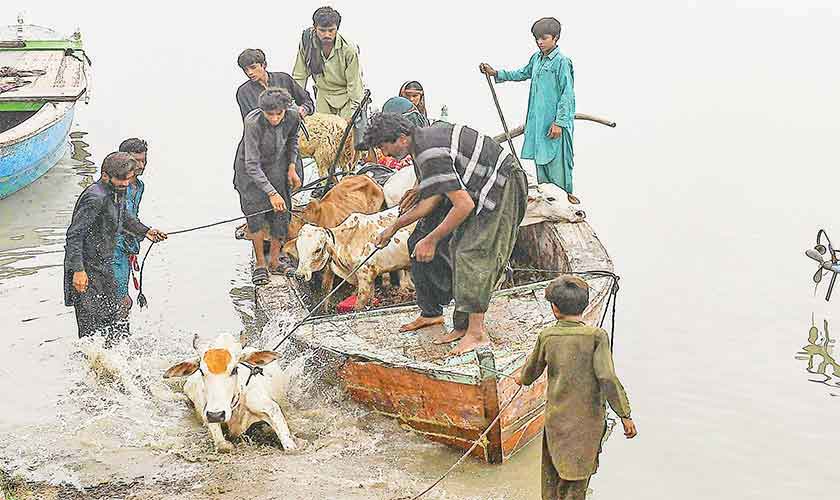ivestock farming has been a significant contributor to the economy and livelihoods of people in Sindh. However, the sector faces several challenges that hinder its growth and potential. One of the significant issues that have plagued livestock keepers in the region is mortality, especially during floods. The ‘blind treatment’ approach, though well-intentioned, has inadvertently led to greater livestock mortality. We must investigate the reasons behind this issue and explore better strategies to create a resilient and productive livestock sector.
During previous floods, 2010, 2011 and 2022, the crisis highlighted the vulnerability of livestock to changing conditions and inadequate preparations. The animal feed was scarce as floodwaters had destroyed fodder crops in many districts. Some of the little feed available was found toxic, forcing livestock owners to switch to alternative feeds without being aware of their impact. Some of the animals had to be fed contaminated fodder or fodder imported from the Punjab.
The sudden dietary change resulted in a higher mortality ratio among animals, particularly ruminants. Efforts to import fodder from other regions led to more outbreaks of disease, as the animals’ immune systems were not prepared for the new challenges. The crisis underlined the lack of awareness and preparedness among livestock keepers and the government, leaving the animals susceptible to preventable diseases and deaths.
During floods, the focus of relief efforts is mostly on providing people with safe drinking water. The needs of the cattle often get overlooked. When animals are left to drink brackish water, they become more susceptible to disease and death. Whenever a flood occurs, it’s crucial to make arrangements for safe water and keeping fodder on raised platforms.
Many of the flood affected regions experience heavy rainfall. Utilising rainwater can help provide sustenance for the animals. However, it’s important to be cautious about introducing new sources of fodder, as sudden changes in diet can lead to significant harm. By transitioning slowly, we can mitigate the risks and take steps to save animals during floods. Supplying fodder from Thar area to the irrigated regions can be safer.
It’s important to note that the community lacks the necessary awareness regarding the potential dangers of abruptly changing the cattle feed. This lack of awareness leads to unfortunate deaths among the animals. Combining the traditional fodder with that acquired from areas like Thar can be a good practice. Such gradual transition can help reduce the risk and the losses among the animal population.
There is a need to estimate the damage done to animal sheds. If there are proper sheds, animals can be better managed.
There is a general lack of understanding about animal vaccination. Many farmers believe that a single vaccine can protect their cattle from all diseases, but this is not true. Each vaccine is designed for a specific disease. A common practice is to administer vaccines only after a disease outbreak has occurred rather than proactively. However, in such cases, the vaccines might not be as effective, resulting in the death of many animals.
Dr Khushi Muhammad, a researcher from the Livestock Department in Sanghar, says there are two types of vaccines: live and dead. These vaccines are designed to combat bacteria or viruses. Live vaccines are effective against certain live bacteria. When animals are in good health, these vaccines are administered, resulting in the formation of antibodies.
Educating livestock keepers about the importance of gradual dietary transition for animals to prevent adverse health effects is necessary. Introducing vaccination schedules and disease prevention measures can significantly reduce mortality rates.
To help villagers keep track of the vaccines, schedules and informational cards are provided before the onset of the pre-monsoon season. Administering six or seven vaccines to the animals during this period can significantly reduce deaths.
By ensuring proper care of animals, including their fodder, addressing the threat of diseases and providing appropriate vaccination, we can effectively safeguard the lives of these animals.
In 2011, the government was unable to take any effective measures. As a result, a large number of animals perished that year. However, in 2022, with the advantage of lessons learned from experience the losses were much lower.
In Sindh, a majority of the population still adheres to traditional practices. However, if they adopt new breeds and employ proper breeding techniques and equipment, they have the potential to achieve higher profits.
Implementing these modern methods can also help mitigate inequalities in various regions. With effective management, it is possible to efficiently raise and handle a larger number of animals.
There is a tendency to mishandle animal treatment. Many animals get treated for diseases other than the ones they are suffering from. This is useless at best and often worse.
There is also a lack of diagnostic facilities, including ultrasound and X-ray laboratories, for diagnosing diseases in animals. Some conditions require surgical intervention. For instance, in fast-spawning animals, if gallstones develop, injections aren’t enough. Some diseases respond only to surgery, yet the farmers sometimes try to treat those with injections.
A centralised diagnostic centre for livestock should be established to ensuring that all kinds of testing is available.
Animal farming in Sindh also suffers from a limited focus on breeding.
Many cattle farms set up by the government fail to provide substantial help to the farmers in this regard. In some cases, people have invested significant amounts of money to acquire farms but not animals. This is particularly evident at Umerkot Cattle Farm and Naukot Cattle Farm. Agriculture contributes nearly 40 percent to Pakistan’s GDP and can do better if appropriate steps are taken.
The Girlando (cow) breed can produce a remarkable 127 litres of milk per day. In comparison, most traditional breeds yield an average of 16 litres. Despite the potential for profit through crossbreeding, there has been a lack of effort.
Crossbreeding offers an opportunity to harness two distinct advantages from different breeds: one with higher meat yield and the other with increased milk production. The Livestock Department can play a pivotal role in this endeavour. They should undertake innovative initiatives at the union council and tehsil levels to enhance animal production.
There is a shortage of dispensaries where animals can receive proper treatment.
The Sindh Livestock Department needs to overhaul its operational approach, think outside the box, and adopt a culture of innovation.
The writer is based in Umerkot. He has more than 13 years of experience in the development sector. He can be reached at [email protected]
https://www.thenews.com.pk/tns/detail/1101773-saving-livestock

